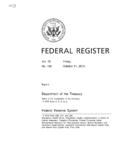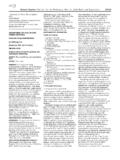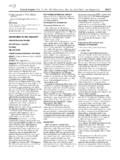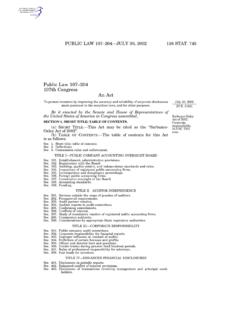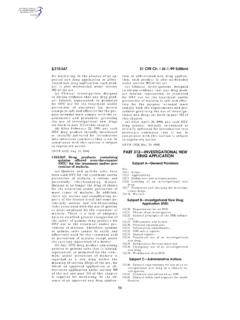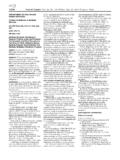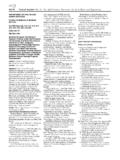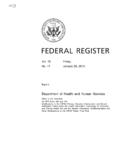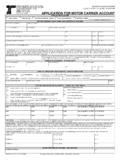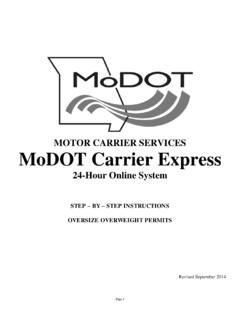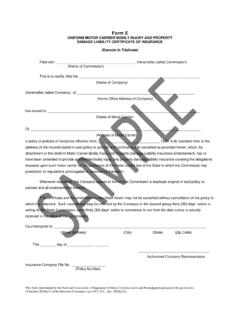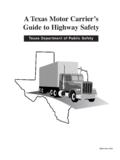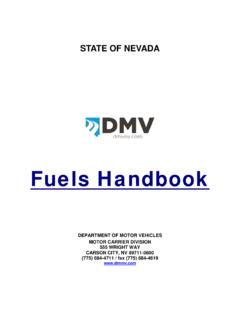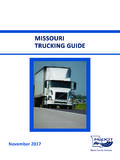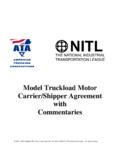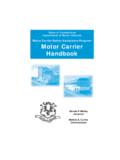Transcription of Department of Transportation
1 Vol. 76 Tuesday, No. 248 December 27, 2011. Part IV. Department of Transportation Federal motor carrier Safety Administration 49 CFR Parts 385, 386, 390, et al. Hours of Service of Drivers; Final Rule mstockstill on DSK4 VPTVN1 PROD with RULES4. VerDate Mar<15>2010 18:00 Dec 23, 2011 Jkt 223001 PO 00000 Frm 00001 Fmt 4717 Sfmt 4717 E:\FR\FM\ 27 DER4. 81134 Federal Register / Vol. 76, No. 248 / Tuesday, December 27, 2011 / Rules and Regulations Department OF Transportation Table of Contents increasing the daily off-duty period I. Summary reduced the risk that a driver would be Federal motor carrier Safety A. Overview driving so long after the start of the duty Administration B. Proposed Rule day that acute fatigue would be extreme. C. Final Rule It also moved drivers toward a 24-hour 49 CFR Parts 385, 386, 390, and 395 D. Summary of Economic Impacts daily clock, which is people's normal E. Overview of Major Comments and pattern, reducing the risk of fatigue [Docket No.]
2 FMCSA 2004 19608] Agency Responses caused from continually changing sleep RIN 2126 AB26 II. Legal Basis periods. The 2003 rule, however, III. Background and Description of the allowed drivers to work 14 hours Hours of Service of Drivers Trucking Industry without a break and to work 80 or more IV. Discussion of All Comments A. Safety hours a week, a substantial increase AGENCY: Federal motor carrier Safety from the previous rule, which allowed Administration (FMCSA), DOT. B. Economic Impacts C. Sleep Loss and Chronic Fatigue about 60 hours in 7 days. ACTION: Final rule. D. New Research Studies Since the 2003 rule was promulgated, E. Driving Time Limits new research studies have demonstrated SUMMARY: FMCSA revises the hours of F. 30-Minute Break Provision that long work hours, both daily and service (HOS) regulations to limit the G. Restart weekly, lead to reduced sleep and, in use of the 34-hour restart provision to H. Duty Period/Driving Window the absence of sufficient recovery time, once every 168 hours and to require that I.
3 Paragraphs (e)(2) and (o) chronic fatigue. Fatigued drivers have anyone using the 34-hour restart J. On-Duty Definition slowed reaction times and a reduced provision have as part of the restart two K. Penalties ability to assess situations quickly. The periods that include 1 to 5 It L. Compliance Dates M. Other Comments research has also shown that also includes a provision that allows commercial motor vehicle (CMV). truckers to drive if they have had a N. Beyond the Scope V. Section-by-Section Analysis drivers (like most other people) are break of at least 30 minutes, at a time VI. Required Analyses unable to assess their own fatigue levels of their choosing, sometime within the A. Executive Order 12866 and Executive accurately and are, therefore, often previous 8 hours. This rule does not Order 13563 unaware that their performance has include a change to the daily driving B. Regulatory Flexibility Act degraded. When driving an 80,000- limit because the Agency is unable to C.
4 Paperwork Reduction Act pound CMV at highway speeds, any definitively demonstrate that a 10-hour D. National Environmental Policy Act delay in reacting to a potentially limit which it favored in the notice of E. Executive Order 13132 (Federalism). dangerous situation can be deadly. In proposed rulemaking (NPRM) would F. Privacy Impact Assessment G. Executive Order 12630 (Taking of addition to the safety concerns, recent have higher net benefits than an 11-hour research has linked long work hours and Private Property). limit. The current 11-hour limit is H. Executive Order 12988 (Civil Justice the resulting curtailment of sleep to a therefore unchanged at this time. The Reform) range of serious health effects, 60- and 70-hour limits are also I. Executive Order 13045 (Protection of particularly when combined with a job unchanged. The purpose of the rule is Children) that is basically sedentary, like truck to limit the ability of drivers to work the J.
5 Executive Order 13211 (Energy Supply, driving. These health conditions . maximum number of hours currently Distribution, or Use) including obesity, high blood pressure, allowed, or close to the maximum, on a K. Executive Order 12898 (Environmental other cardiovascular diseases, diabetes, continuing basis to reduce the Justice). and sleep apnea not only shorten possibility of driver fatigue. Long daily L. Unfunded Mandate Reform Act VII. Bibliography drivers' lives, but also can result in and weekly hours are associated with an substantial ongoing medical costs and increased risk of crashes and with the I. Summary put drivers' medical certifications at chronic health conditions associated risk. CMV drivers suffer from these A. Overview with lack of sleep. These changes will conditions at a higher rate than the affect only the small minority of drivers The goal of this rulemaking is to population as a whole. who regularly work the longer hours.
6 Reduce excessively long work hours that Today's rule will reduce the risk of DATES: Effective date: February 27, 2012. increase both the risk of fatigue-related fatigue and fatigue-related crashes and Compliance date: The rule changes crashes and long-term health problems the harm to driver health in several that affect Appendix B to Part 386 for drivers. A rule cannot ensure that ways. While the rule allows a driver Penalty Schedule; Violations and drivers will be rested, but it can ensure flexibility in when to take a mandatory Monetary Penalties; the oilfield that they have enough time off to obtain 30 minute break, it prohibits a driver exemption in (d)(2); and the adequate rest on a daily and weekly from driving if more than 8 hours have definition of on-duty time in basis. The objective of the rule, passed since the driver's last off-duty or must be complied with on the effective therefore, is to reduce both acute and sleeper berth break of at least 30.
7 Date. Compliance for all the other rule chronic fatigue by limiting the minutes; research indicates that such changes is not required until July 1, maximum number of hours per day and breaks alleviate fatigue and fatigue- 2013. week that the drivers can work. related performance degradation. The 2003 hours-of-service (HOS) rule Because research has shown that long FOR FURTHER INFORMATION CONTACT: Mr. shortened the driving window to 14 weekly work hours are associated with mstockstill on DSK4 VPTVN1 PROD with RULES4. Thomas Yager, Chief, Driver and carrier consecutive hours and increased the off- a higher risk of crashes, sleep loss, and Operations Division, Federal motor duty period from 8 to 10 hours, but negative health effects, the rule also carrier Safety Administration, increased driving time from 10 to 11 limits the use of the restart to once a Department of Transportation , 1200 hours and allowed drivers to restart week, which, on average, will cut the New Jersey Avenue SE.
8 , Washington, their duty time calculations whenever maximum work week from 82 to 70. DC 20590 (202) 366 4325. they took at least 34 consecutive hours hours. The provision allows drivers to SUPPLEMENTARY INFORMATION: off. Limiting the driving window and work intensely for one week, but will VerDate Mar<15>2010 18:00 Dec 23, 2011 Jkt 223001 PO 00000 Frm 00002 Fmt 4701 Sfmt 4700 E:\FR\FM\ 27 DER4. Federal Register / Vol. 76, No. 248 / Tuesday, December 27, 2011 / Rules and Regulations 81135. require them to compensate by taking drivers. This rule will address one of the the docket, mostly in opposition to a 10- more time off in the following week. causes of those crashes. The Agency hour driving limit; and completed Research has long demonstrated that estimates that the benefits of the rule elaborate analyses in accordance with daytime sleep is shorter in duration and (reduction in crashes and improved Presidential Executive Order 13563, lower in quality than nighttime sleep.)
9 Driver health) will outweigh the costs. issued January 18, 2011, '' Improving The rule requires any driver working The cost of the rule represents a small Regulation and Regulatory Review,'' [76. long enough to need a restart to take off fraction of one percent of trucking FR 3821, January 21, 2011] of the costs at least 34 consecutive hours that industry revenues and is the cost- and benefits to health and safety of include 2 periods between 1 and 5 equivalent of less than a 3 cent-a-gallon 9-, 10-, and 11-hour driving limits. , the window of circadian low. This increase in the price of diesel fuel to the 1. 9-Hour Driving Limit. The Agency provision will give those drivers who long-haul industry. found that a 9-hour driving limit both routinely work at night and put in generally has negative net benefits ( , B. Proposed Rule its costs exceed its benefits). In most very long work weeks an opportunity to overcome the chronic fatigue that can On December 29, 2010, FMCSA cases the 11-hour limit has positive net build up when working nights.
10 Published a notice of proposed benefits. For these reasons, the Agency FMCSA has been engaged in long- rulemaking (NPRM) to revise the HOS has not adopted a 9-hour driving limit. term rulemaking related to its hours of rules (75 FR 82170). The Agency sought 2. 10-Hour Driving Limit. The 10-hour service regulations for commercial truck comment on both a 10- and an 11-hour limit has positive benefits in drivers. Like the Federal Aviation daily driving limit. The NPRM proposed approximately half the cases, with the Administration (FAA), FMCSA is to retain the 34-hour restart, but with 11-hour limit having substantially working to address the universality of two qualifications: The restart must higher net benefits than the 10-hour factors that lead to fatigue. However, the include two consecutive periods limit in most cases. A 10-hour limit, on FAA has taken a different approach in between midnight and 6 and could the other hand, might save more lives addressing fatigue risk among pilots be used only once every 168 hours (7 and prevent more crashes than an 11- than FMCSA has with respect to days).

